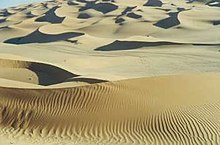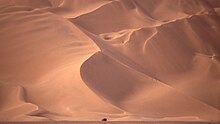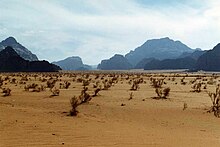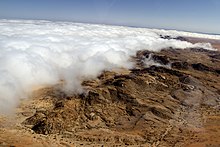desert
The areas of the earth with little or no vegetation are called desert . Deserts are caused either by a lack of warmth ( cold desert , ice desert ) in the subpolar and subnival regions, overgrazing or a lack of water ( dry desert , hot desert ). Deserts are part of the anecumene .

Geomorphological classification of desert species


Sand desert
The sandy desert is called Erg in Arabic , and Edeya in the Western Sahara and the Libyan Desert . A sand desert is a desert with a surface that consists predominantly of quartz sand that was created by soil erosion in a gravel desert or that was blown in from other regions. Sandy deserts, although they are widely mistakenly considered synonymous with the desert phenomenon , only take up about 20% of the desert area of the earth and also of the Sahara.
The living conditions in the sandy deserts are tougher than in others. They are available with and without dunes , which can be relatively stable solidified and in its lower part as in the southern sea of sand, where so-called. Gassis form, or as in the northern sand sea Egypt - at about Farafra - as shifting sand dunes occur in the form of (depending depending on the prevailing wind direction) transverse, longitudinal, star or sickle dunes. The highest sand dunes can be found in Algeria , the longest is the Abu Muharek with about 600 km. Only solidified sand plains are easy to drive on, otherwise dune fields such as the Erg of Bilma are difficult to pass even with off-road vehicles . The world's largest sandy desert is the Rub al-Chali in Arabia , and the second largest is the Taklamakan .
Gravel desert
Gravel deserts are called Reg in the Western Sahara and Serir in the Central Sahara . Gravel deserts arise after the erosion of stone or rock deserts ( accumulation of coarser grain sizes by blowing out the finer grain sizes) or through the deposition of gravel in the run-up to glaciers . Car tracks last a particularly long time here. Gravel deserts are easily passable.

Stone or rock desert
Stone or rock deserts are also called hammada . The surface of this type of desert is littered with densely blocky, angular debris or rock material, accumulated as a result of physical weathering and the expansion of the fine material. Most of them are plateaus covered with rubble. Hardly passable by car, except on old caravan roads , which you can usually recognize as in other desert forms on the Alamat (small stone pyramids as signposts) and on the camel carcasses that line them. Desert varnish is increasingly found on the surface of the rocks .

Salt desert
Salt deserts are called Schott in Algeria and Tunisia , Sebkha in the central and eastern Sahara and Grara in Libya . Salt deserts mostly arise in arid , drainless sedimentary basins due to strong evaporation . Very many deserts of this type are in Iran and Central Asia . They are difficult to pass and should be avoided as far as possible because of the pools and swamp fields under the salt crust. The salt of these bulkheads does not represent the remains of an old sea, but comes from the washings of deposits washed down from the surrounding mountainous countries, which often contain abundant salt, whereby it is in drainless depressions such. B. the Qattara Depression naturally accumulated and thick, heavily salt-enriched clay and loam surfaces, so-called salt plains or alkali flat . After precipitation, these turned into salt lakes or salt swamps, which consist of a muddy mixture of clay, salt and sand. The names of the north Egyptian Wadi El-Natrun, which runs parallel to the Cairo - Alexandria road , the Libyan town El Atrun on Cyrenaica and the north-west Sudanese oasis El-Atrun are signs of this situation.
ice desert
The climatic term of the cold desert corresponds to the geomorphological type of the ice desert (see below).
Classification according to climatic origin
The deserts of the earth can be classified climatically into five types, depending on the cause of their drought.
2. Cold coastal desert:
Located on cold water and therefore very dry and mostly sterile, the Atacama desert is like here in Cobija (Chile) .3. Rain shadow desert :
Shielded by mountains, there is hardly any rainfall in the Mojave Desert in the USA.4. Inland desert:
The Taklamakan Desert in China is further away from the sea than anything else, almost in the center of the Eurasian continent .5. Polar desert:
In the McMurdo Dry Valleys in Antarctica it is so dry that there is not even ice over large areas on the permafrost floor.
Subtropical desert
Subtropical deserts, also known as trade deserts or tropic deserts , lie in two broad bands that span almost the entire earth, with a geographical latitude of up to about 30 ° on both sides of the earth's equator . Examples are most of the Sahara and the Kalahari .
In both the northern and southern hemispheres, the air masses coming from the original trade wind are forced to descend by the high pressure areas that frequently occur there. This warms them up, causing the relative humidity to decrease and dry, cloudless climates to arise.
The high pressure areas come about through the intertropical convergence zone, ITC for short . Due to the strong solar radiation over a large angle, the earth is particularly heated in the equatorial region. A lot of water also evaporates. Since there is an inversion layer in the tropopause, the air masses cannot rise any further. They are diverted to the north and south. It starts to rain due to the condensation of the water vapor. In the tropic, the cooled air, which no longer contains moisture, begins to sink. Descending air masses always cause the clouds to dissolve. Near the ground, the air flows back into the equatorial region. The Coriolis deflection creates the trade winds.
Cold coastal desert
The cold coastal desert is a special form of the subtropical desert in many ways. Trade winds and special ocean currents increase their dryness. The cold rising water of the sea cools the air masses above it. The humidity contained in these air masses condenses , so the relative humidity increases and clouds form. However, the clouds have lost so much temperature that they can no longer rise - a stable layering and therefore fog is created. If these air masses come into the desert, they are heated up and lose a lot of relative humidity, the clouds dissolve. Alexander von Humboldt once described the coastal desert of the Atacama as “so close to the water and yet so poor in water” .
There are three well-developed cases of this type of desert worldwide. The Namib on the coast of southwest Africa, the Atacama on the Chilean and Peruvian coasts and the desert on the Pacific coast of Baja California in Mexico. Some borderline cases exist on the northwest coast of Africa , the easternmost of the Canary Islands , the northwest coast of Australia and possibly the coast of Somalia .
Rain shadow desert
Rain shadow deserts are caused by the shape of the earth's surface and are therefore also called relief deserts. They occur in the interior of the continents, especially on high mountain ranges or in basins. In such regions there is only little precipitation because they are in the rain shadow on the leeward side of the peripheral mountains.
The humid air masses are forced to rise in front of the mountains. Up on the mountain range, the air is cooler and can therefore store less water: The moist, cold air masses are forced to rain down. On the other side of the mountain range, the air heats up overall (due to the moist adiabatic cooling and the dry adiabatic heating) and the warm, dry air masses sink. Deserts form below due to the warmth and drought. A typical rain shadow desert is the Judah desert .
Inland desert
Inland deserts are located south of the southern or north of the northern tropics. The best known are the Gobi Desert , Taklamakan and the Great Basin .
Inland continental deserts and rain shadow deserts are grouped together by some researchers as extra-tropical deserts .
Polar desert
The polar regions are deserts. They receive very little rainfall and the moisture is mostly in a frozen form, which means that the water is not available for plants. Due to the extremely low temperatures, the ground is frozen and the air is very dry. A well-known example are the hyperarid McMurdo dry valleys in Antarctica, which are among the driest areas on earth.
More desert types
Wind desert
Wind deserts can only be found on sub-Antarctic islands in the South Atlantic , south of the 50th parallel . In this area of constant westerly storms, which accompany drizzle and fog all year round, no trees can thrive due to a lack of wind protection. Only mosses, ferns and lichens are found.

Semi-desert
The semi-desert represents a landscape zone that is slightly more humid than the real desert, but still drier than the thorn savannah . It is mostly located on the edge (in the transition zone) of such a “full desert” - see also the Sahel zone .
Edaphic desert
Extensive areas with no vegetation due to pedological ( edaphic ) reasons or due to soil erosion are often called "deserts" in common parlance. In edaphic (soil-related) deserts, added precipitation is removed very quickly in the highly water-permeable soil . Water cannot, or only very poorly, store in the soil and there is little for plant growth. The huge gravel corridors in the Icelandic highlands form a desert landscape despite considerable amounts of precipitation and melt water.
The appearance of deserts applies in particular to habitats shaped by sand, such as coastal dunes . The dune landscape of the Brazilian Lençóis Maranhenses is often referred to as a desert. In most definitions of desert, however, these regions are not included, since the vegetation poverty here is not due to water shortages (the Lençóis Maranhenses, for example, receive around 2000 millimeters of annual rainfall).
ecology
Survival in desert areas, with their particular environmental conditions characterized by a lack of water , forces plants and animals , but also humans, to make very specific adjustments . Rain showers are rare, but when it rains it is usually very heavy. Then the desert blossoms : Colorful desert plants grow, but because of the lack of water, they have a short life cycle. Nevertheless, u. a. even these short growing seasons an often astonishingly rich animal life.
Flora and vegetation
Deserts are characterized by a lack of vegetation or even a lack of vegetation, only around a quarter of all desert areas are overgrown. The existing vegetation ( xerophytes , halophytes ) is determined by shrubs, grasses and certain deep-rooted trees (e.g. acacias in the Kalahari) that are adapted to drought or increased salt tolerance . They differ in water-saving, water-storing, underground perennial plants and in plants with a short growing season. For example, the Arthraerua leubnitziae shrub (a foxtail plant ) is native to the fog zone of the Namib Desert as the most common representative of permanent vegetation; it can use the high humidity of the fog. Plants like this succeed in maintaining their water balance even during extreme and long-lasting periods of drought ( using the example of Arthraerua leubnitziae for several thousand years) .
fauna
In many of the world's deserts, numerous animal species can be found despite the supposedly hostile conditions. For example, the goiter gazelle and steppe iltis are native to the Gobi, alongside other large animals , and snow leopards and wolves are also found at times . Reptiles and especially the extraordinarily adaptable arthropods (e.g. insects and scorpions ) can be found in the arid regions even more numerous than mammals .
The animals that live in hot sandy deserts often have very obvious adaptations to the high surface temperatures of the sand: for example, insects that walk on the sand during the day usually have exceptionally long pegs, as the temperature drops significantly just a few centimeters above the sand. Because of this and because they move quickly, the animals are able to protect themselves from deadly overheating. The long legs of the camels could also have developed as protection from the radiated heat.
Cultural history
In terms of cultural history, the desert has played an important role in European historiography and literature since ancient times . On the one hand, since Herodotus , the desert has symbolized that which is alien and different, which has escaped European access. On the other hand, the desert also offered retreats. In particular through the Bible ( excerpt from Egypt of the Israelites, temptations of Christ ) and the later hagiographic literature ( hermits ) an image of the desert was transported to Europe, which in essence still has an effect today. Through the domestication of the dromedary , humans managed to penetrate deeper into the great deserts or to cross them. This enabled the desert to become human habitat.
devastation
The emergence of new deserts and the expansion of existing ones is mostly caused by humans ( desertification ). These include overgrazing , unadapted agriculture and deforestation . Natural causes of devastation are periods of drought , the spreading of sand dunes or the fraying of desert edges. Devastation is promoted by blowing (wind), runoff (water), salinization and skeletonization.
The UN organization UNCCD is fighting against the further spread of the deserts. 2006 was declared the International Year of Deserts and Desertification .
The largest deserts
| No. | Area (km²) | Surname | continent |
|---|---|---|---|
| 1. | 13,200,000 | Antarctic | Antarctica |
| 2. | 8,700,000 | Sahara | Africa |
| 3. | 2,300,000 | Gobi | Asia |
| 4th | 2,160,000 | Greenland | North America |
| 5. | 1,560,000 | Australian deserts | Australia |
| 6th | 1,300,000 | Arab deserts | Asia |
| 7th | 900,000 | Kalahari | Africa |
| 8th. | 330,000 | Taklamakan | Asia |
| 9. | 320,000 | Sonora | North America |
| 10. | 273,000 | Karakum | Asia |
| 11. | 273,000 | Tharr and Cholistan | Asia |
Taken together, all of the world's deserts cover about a fifth of the Earth's total land area , which is almost 30 million square kilometers. If the semi-deserts are also included, this results in about a third of the land area, i.e. a little less than 50 million square kilometers. In total, they cover almost 10% of the entire earth's surface.
Desert climate
Dry deserts can be subject to strong temperature fluctuations, depending on the distance from the sea and the time of year. During the day, the soil only heats up superficially due to the poor heat conduction of the quartz-containing and aerated desert soil. In addition, compared to moist soil, it can only store little thermal energy (water can store around six times as much energy as sand). Due to the low cloud formation , heat radiation penetrates undamped to the ground during the day and heats it up very strongly (up to around 70 ° C), but at night heat radiates unhindered into space ( clouds act as an insulating layer, both from space to earth and vice versa). This leads to temperature differences of 50 K and more, especially in "winter" and far from the sea, which ensures temperature equalization.
This effect enables a modest life even in the driest deserts . Because of the strong cooling, a dew point close to the ground is reached. Plants and other living beings can then live from the dew drops formed.
Due to the strong temperature fluctuations, physical weathering in the desert is enormously promoted. Chemical weathering, on the other hand, takes place very slowly due to the lack of water (see desert varnish ).
literature
- Wolf Dieter Blümel: Deserts. Origin, characteristics, habitat . UTB, Stuttgart 2013, ISBN 978-3-8252-3882-7 .
- Uwe Lindemann: The desert. Terra incognita - experience - symbol. A genealogy of occidental ideas of the desert in literature from antiquity to the present . Heidelberg 2000, ISBN 3-8253-1006-X .
- Michael Martin (photographer) : The deserts of the earth . Frederking & Thaler, Munich 2004, ISBN 3-89405-435-2 (This book offers an overview of all deserts on earth).
- Dieter Jäkel: Dune deserts and loess in China . In: Naturwissenschaftliche Rundschau . tape 59 , no. 11 , 2006, ISSN 0028-1050 , p. 594-601 .
- Bursche, Detlef: Landscapes of the earth . Scientific Book Society, Darmstadt 2005.
- Hornetz, Berthold: Savannah, steppe and desert zones . Westermann, Braunschweig 2003.
- Mensching, Horst: Physical geography of dry areas . Scientific Book Society, Darmstadt 1982.
- Thomas, David: Arid zone geomorphology . Wiley, Chichester 1997.
- Besler, Helga (1983) The wind as a producer of deserts. Geosciences in our time; 1, 4; 109-114; doi: 10.2312 / geosciences.1983.1.109 .
Movies
- Planet earth . Desert worlds. Great Britain, documentary, 45 min. A film by Alastair Fothergill, production: BBC
Web links
Individual evidence
- ↑ a b c d e f g h Logan, Richard F. "Causes, climates and distribution of deserts." Desert biology: special topics on the physical and biological aspects of arid regions 1 (1968): 21-50. online p. 23 ff
- Jump up ↑ Ralph D. Lorenz, James R. Zimbelman: Dune Worlds: How Windblown Sand Shapes Planetary Landscapes. Springer, Berlin, Heidelberg etc. 2014. ISBN 978-3-540-89725-5 . therein chap. 11.3.8 Lençóis Maranhenses on page 127.
- ^ Sternberg, Troy, Henri Rueff, and Nick Middleton. "Contraction of the Gobi Desert, 2000–2012." Remote Sensing 7.2 (2015): 1346–1358. ( PDF )
- ↑ planet earth : summary ( memento of February 4, 2009 in the Internet Archive ) of the ARD









